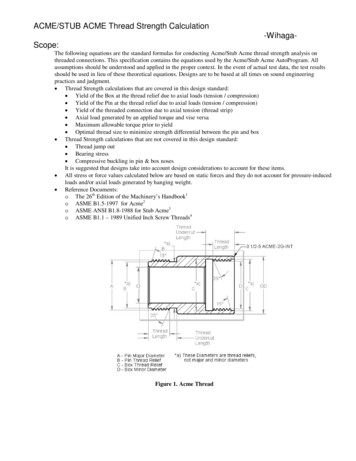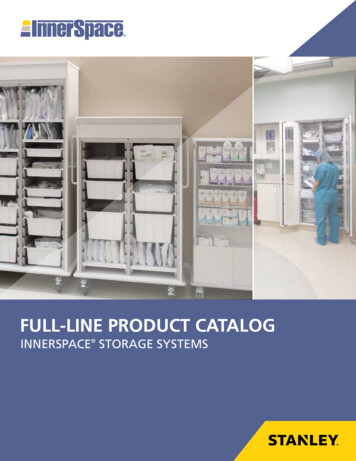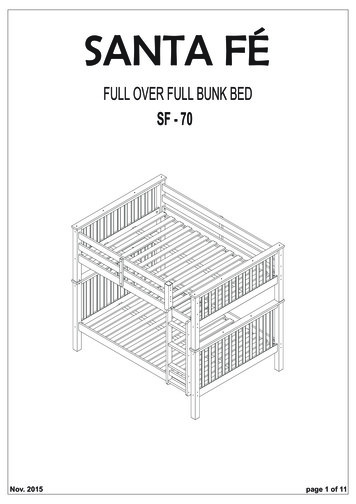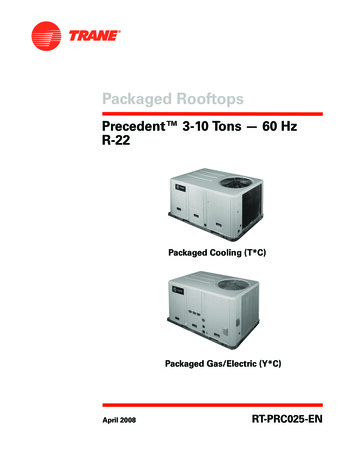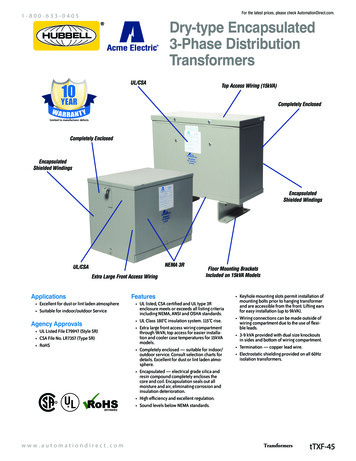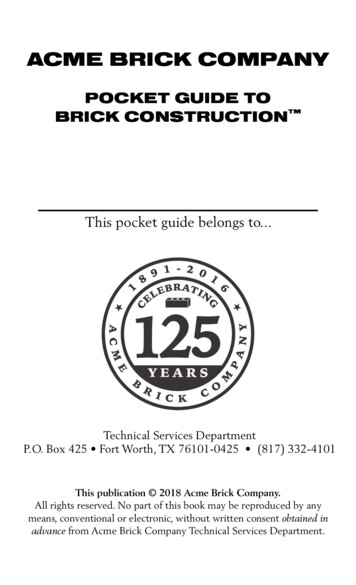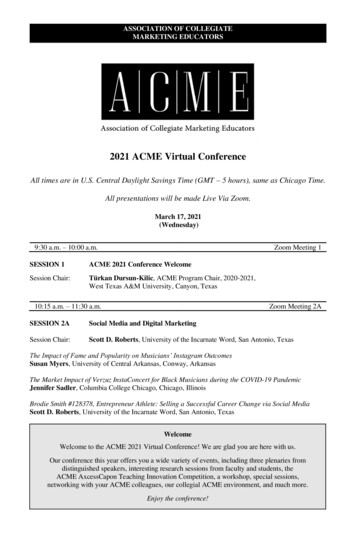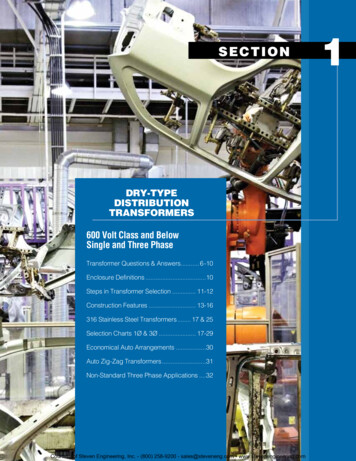
Transcription
SECTIONDRY-TYPEDISTRIBUTIONTRANSFORMERS600 Volt Class and BelowSingle and Three PhaseTransformer Questions & Answers. 6-10Enclosure Definitions.10Steps in Transformer Selection. 11-12Construction Features. 13-16316 Stainless Steel Transformers. 17 & 25Selection Charts 1Ø & 3Ø. 17-29Economical Auto Arrangements.30Auto Zig-Zag Transformers.31Non-Standard Three Phase Applications.32Courtesy of Steven Engineering, Inc. - (800) 258-9200 - sales@steveneng.com - www.stevenengineering.com1
SECTION1DRY-TYPE DISTRIBUTION TRANSFORMERSTransformer Questions & Answers1. What is a transformer and how does it work?A transformer is an electrical apparatus designed to convertalternating current from one voltage to another. It can bedesigned to “step up” or “step down” voltages and workson the magnetic induction principle. A transformer has nomoving parts and is a completely static solid state device,which insures, under normal operating conditions, a longand trouble-free life. It consists, in its simplest form, oftwo or more coils of insulated wire wound on a laminatedsteel core. When voltage is introduced to one coil, calledthe primary, it magnetizes the iron core. A voltage is theninduced in the other coil, called the secondary or output coil.The change of voltage (or voltage ratio) between the primaryand secondary depends on the turns ratio of the two coils.6. Can transformers be used in parallel? Single phasetransformers can be used in parallel only when theirimpedances and voltages are equal. If unequal voltagesare used, a circulating current exists in the closed networkbetween the two transformers, which will cause excessheating and result in a shorter life of the transformer. Inaddition, impedance values of each transformer must bewithin 7.5% of each other. For example: Transformer A hasan impedance of 4%, transformer B which is to be parallelto A must have an impedance between the limits of 3.7%and 4.3%. When paralleling three phase transformers, thesame precautions must be observed as listed above, plusthe angular displacement and phasing between the twotransformers must be identical.2. What are taps and when are they used? Taps areprovided on some transformers on the high voltage windingto correct for high or low voltage conditions, and still deliverfull rated output voltages at the secondary terminals.Standard tap arrangements are at two-and-one-half andfive percent of the rated primary voltage for both high andlow voltage conditions. For example, if the transformer hasa 480 volt primary and the available line voltage is runningat 504 volts, the primary should be connected to the 5%tap above normal in order that the secondary voltage bemaintained at the proper rating. The standard ASA andNEMA designation for taps are “ANFC” (above normal fullcapacity) and “BNFC” (below normal full capacity).7. Can Acme Transformers be reverse connected?ACME dry-type distribution transformers can be reverseconnected without a loss of kVA rating, but there arecertain limitations. Transformers rated 1 kVA and largersingle phase, 3 kVA and larger three phase can be reverseconnected without any adverse effects or loss in kVAcapacity. The reason for this limitation in kVA size is, theturns ratio is the same as the voltage ratio. Example: Atransformer with a 480 volt input, 240 volt output— canhave the output connected to a 240 volt source and therebybecome the primary or input to the transformer, then theoriginal 480 volt primary winding will become the outputor 480 volt secondary. On transformers rated below 1 kVAsingle phase, there is a turns ratio compensation on thelow voltage winding. This means the low voltage windinghas a greater voltage than the nameplate voltage indicatesat no load. For example, a small single phase transformerhaving a nameplate voltage of 480 volts primary and 240volts secondary, would actually have a no load voltageof approximately 250 volts, and a full load voltage of 240volts. If the 240 volt winding were connected to a 240 voltsource, then the output voltage would consequently beapproximately 460 volts at no load and approximately442 volts at full load. As the kVA becomes smaller, thecompensation is greater— resulting in lower output voltages.When one attempts to use these transformers in reverse, thetransformer will not be harmed; however, the output voltagewill be lower than is indicated by the nameplate.3. What is the difference between “Insulating,”“Isolating,” and “Shielded Winding” transformers?Insulating and isolating transformers are identical. Theseterms are used to describe the isolation of the primaryand secondary windings, or insulation between the two.A shielded transformer is designed with a metallic shieldbetween the primary and secondary windings to attenuatetransient noise. This is especially important in criticalapplications such as computers, process controllers andmany other microprocessor controlled devices. All two,three and four winding transformers are of the insulating orisolating types. Only autotransformers, whose primary andsecondary are connected to each other electrically, are notof the insulating or isolating variety.64. Can transformers be operated at voltages other thannameplate voltages? In some cases, transformers can beoperated at voltages below the nameplate rated voltage. InNO case should a transformer be operated at a voltage inexcess of its nameplate rating, unless taps are provided forthis purpose. When operating below the rated voltage, thekVA capacity is reduced correspondingly. For example, ifa 480 volt primary transformer with a 240 volt secondary isoperated at 240 volts, the secondary voltage is reduced to120 volts. If the transformer was originally rated 10 kVA, thereduced rating would be 5 kVA, or in direct proportion to theapplied voltage.8. Can a Single Phase Transformer be used on aThree Phase source? Yes. Any single phase transformercan be used on a three phase source by connecting theprimary leads to any two wires of a three phase system,regardless of whether the source is three phase 3-wire orthree phase 4-wire. The transformer output will be singlephase.5. Can 60 Hz transformers be operated at 50 Hz?ACME transformers rated below 1 kVA can be used on 50Hz service. Transformers 1 kVA and larger, rated at 60 Hz,should not be used on 50 Hz service, due to the higherlosses and resultant heat rise. Special designs are requiredfor this service. However, any 50 Hz transformer will operateon a 60 Hz service.10. How do you select transformers?(1) Determine primary voltage and frequency.(2) Determine secondary voltage required.(3) Determine the capacity required in volt-amperes.9. Can Transformers develop Three Phase powerfrom a Single Phase source? No. Phase converters orphase shifting devices such as reactors and capacitors arerequired to convert single phase power to three phase.This is done by multiplying the load current (amperes) bythe load voltage (volts) for single phase. For example: if theACME ELECTRIC MILWAUKEE, WI 800.334.5214 acmetransformer.comCourtesy of Steven Engineering, Inc. - (800) 258-9200 - sales@steveneng.com - www.stevenengineering.com
SECTION1DRY-TYPE DISTRIBUTION TRANSFORMERSload is 40 amperes, such as a motor, and the secondaryvoltage is 240 volts, then 240 x 40 equals 9600 VA. A 10kVA (10,000volt-amperes) transformer is required. ALWAYSSELECT THE TRANSFORMER LARGER THAN THE ACTUALLOAD. This is done for safety purposes and allows forexpansion, in case more load is added at a later date. For 3phase kVA, multiply rated volts x load amps x 1.73 (squareroot of 3) then divide by 1000.(4) Determine whether taps are required. Taps areusually specified on larger transformers.(5) Use the selection charts in Section I.11. What terminations are provided? Primary andSecondary Terminations are provided on ACME Dry-TypeTransformers as follows:No lugs— lead type connection on0-25 kVA single phase0-15 kVA three phaseBus-bar terminations(drilled to NEMA standards)37.5 -250 kVA single phase25-500 kVA three phaseinsulation class 130 C. Compound filled transformers useinsulation class 180 C. Larger ventilated transformers aredesigned to use 220 C insulation. All of these insulationsystems will normally have the same number of yearsoperating life. A well designed transformer, observing thesetemperature limits, will have a life expectancy of 20-25years.17. Why should Dry-Type Transformers never be overloaded? Overloading of a transformer results in excessivetemperature. This excessive temperature causesoverheating which will result in rapid deterioration of theinsulation and cause complete failure of the transformer coils.18. Are temperature rise and actual surfacetemperature related? No. This can be compared with anordinary light bulb. The filament temperature of a light bulbcan exceed 2000 degrees, yet the surface temperature ofthe bulb is low enough to permit touching with bare hands.19. What is meant by “impedance” in transformers?Impedance is the current limiting characteristic of atransformer and is expressed in percentage.Total Winding Temperature C12. Can 60 Hz transformers be used at higher frequencies?ACME transformers can be used at frequencies above 60 Hzup through 400 Hz with no limitations provided nameplatevoltages are not exceeded. However, 60 Hz transformers willhave less voltage regulation at 400 Hz than 60 Hz.13. What is meant by regulation in a transformer?Voltage regulation in transformers is the difference betweenthe no load voltage and the full load voltage. This is usuallyexpressed in terms of percentage. For example: A transformerdelivers 100 volts at no load and the voltage drops to 95volts at full load, the regulation would be 5%. ACME drytype distribution transformers generally have regulationfrom 2% to 4%, depending on the size and the applicationfor which they are used.14. W hat is temperature rise in a transformer?Temperature rise in a transformer is the temperature ofthe windings and insulation above the existing ambient orsurrounding temperature.15. What is “Class” in insulation? Insulation classwas the original method used to distinguish insulatingmaterials operating at different temperature levels. Letterswere used for different designations. Letter classificationshave been replaced by insulation system temperaturesin degrees Celsius. The system temperature is themaximum temperature at the hottest spot in the winding(coil). Graphical representations of six insulation systemsrecognized by Underwriters’ Laboratories, Inc. are shown inFigure A. These systems are used by Acme for a large partof the product line.16. Is one insulation system better than another?Not necessarily. It depends on the application and thecost benefit to be realized. Higher temperature classinsulation systems cost more and larger transformers are moreexpensive to build. Therefore, the more expensive insulationsystems are more likely to be found in the larger kVA units.Referring to Figure A, small fractional kVA transformers use2203018025COIL HOT SPOTDIFFERENTIAL10510AV. WINDINGRISE55AMBIENT401301015011580404040AGENCY: UL/ANSI 1561 MARCH 1987Figure A20. Why is impedance important? It is used for determiningthe interrupting capacity of a circuit breaker or fuse employedto protect the primary of a transformer. Example: Determinea minimum circuit breaker trip rating and interrupting capacityfor a 10 kVA single phase transformer with 4% impedance,to be operated from a 480 volt 60 Hz source.Calculate as follows:Normal Full Load Current Nameplate Volt Amps10,000 VA Line Volts480 V20.8 AmperesMaximum Short Circuit Amps Full Load Amps20.8 Amps 4%4%520 AmpsThe breaker or fuse would have a minimum interrupting ratingof 520 amps at 480 volts.ACME ELECTRIC MILWAUKEE, WI 800.334.5214 acmetransformer.comCourtesy of Steven Engineering, Inc. - (800) 258-9200 - sales@steveneng.com - www.stevenengineering.com7
SECTION1DRY-TYPE DISTRIBUTION TRANSFORMERSExample: Determine the interrupting capacity, in amperes, ofa circuit breaker or fuse required for a 75 kVA, three phasetransformer, with a primary of 480 volts delta and secondaryof 208Y/120 volts. The transformer impedance (Z) 5%. If thesecondary is short circuited (faulted), the following capacitiesare required:Normal Full Load Current Volt Amps 3 x Line Volts90 Amps75,000 VA 3 x 480 VMaximum Short Circuit Line Current Full Load Amps 90 Amps5%5%1,800 AmpsThe breaker or fuse would have a minimum interrupting rating of1,800 amps at 480 volts.NOTE: The secondary voltage is not used in the calculation.The reason is the primary circuit of the transformer is the onlywinding being interrupted.21. Can Single Phase Transformers be used for Three Phaseapplications? Yes. Three phase transformers are sometimesnot readily available whereas single phase transformers cangenerally be found in stock. Three single phase transformers canbe used in delta connected primary and wye or delta connectedsecondary. They should never be connected wye primary to wyesecondary, since this will result in unstable secondary voltage.The equivalent three phase capacity when properly connectedof three single phase transformers is three times the nameplaterating of each single phase transformer. For example: Three10 kVA s ingle phase transformers will accommodate a 30 kVAthree phase load.22. Does ACME provide “Zig-Zag” Grounding Transformers?Yes. Please refer to Page 31 for a special diagram whichcan be used to connect standard single phase off-the-shelftransformers in a three phase zig-zag manner. This system canbe used for either grounding or developing a fourth wire froma three phase neutral. An example would be to change a 480V — three phase — three wire system to a 480Y/277 V — threephase — four wire system.23. What color are ACME Dry-Type Transformers?ASA 61 (NEMA) lig
10,000 VA Line Volts 480 V 20.8 Amperes Maximum Short Circuit Amps Full Load Amps 20.8 Amps 4% . at 480 volts. load is 40 amperes, such as a motor, and the secondary voltage is 240 volts, then 240 x 40 equals 9600 VA. A 10 kVA (10,000volt-amperes) transformer is required. ALWAYS SELECT THE TRANSFORMER LARGER THAN THE ACTUAL LOAD. This is done for safety purposes and allows
